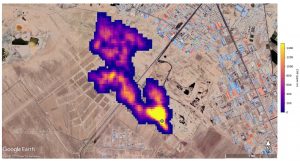China has broken months of silence about the status of its Mars rover Zhurong, saying an excessive accumulation of sand and dust is the likely cause of its inactivity.
The fully robotic rover has been in longer-than-expected hibernation since May 2022, when it entered a planned sleep mode as falling solar radiation with the arrival of winter cut its power generation.
An unforeseen pile-up of dust most likely affected power generation and Zhurong’s ability to wake up, Chinese state television reported on Tuesday, quoting Zhang Rongqiao, chief designer of China’s Mars exploration programme.
Also on AF: China Looking to 3D Print Lunar Buildings Using Moon Soil
Named after a mythical Chinese god of fire, Zhurong was supposed wake up in December 2022.
But official images from a camera aboard a NASA probe orbiting Mars showed China’s rover had not moved since at least September.

The 240-kg vehicle holds six scientific instruments including a high-resolution topography camera. It was tasked with studying the surface soil and atmosphere on Mars.
Powered by solar energy, Zhurong also looked for signs of ancient life, including any subsurface water and ice, using a ground-penetrating radar.
The rover landed on Mars, with no mishap, in May 2021. It explored the Martian surface for 358 days and travelled for 1,921 metres (2,100 yards), Zhang said, far exceeding its original mission time-span of three months.
Aside from Zhurong, two other robotic rovers have been operating on Mars – NASA’s Perseverance and Curiosity. The former has been roaming the planet’s surface for more than two years and the latter for over a decade.
- Reuters, with additional editing by Vishakha Saxena
Also read:
China to Begin Building Moon Base With Lunar Soil by 2028
China to Send Up Asteroid Probe, Explore Comet in 2025
China’s Space Programme Finds Evidence of Water on Moon
China Calls NASA Chief ‘Colonial,’ Says Won’t Take Over Moon
China Discovers New Mineral on The Moon – Global Times
US Wary of China Plan for Weapons System on Moon – AS USA
























